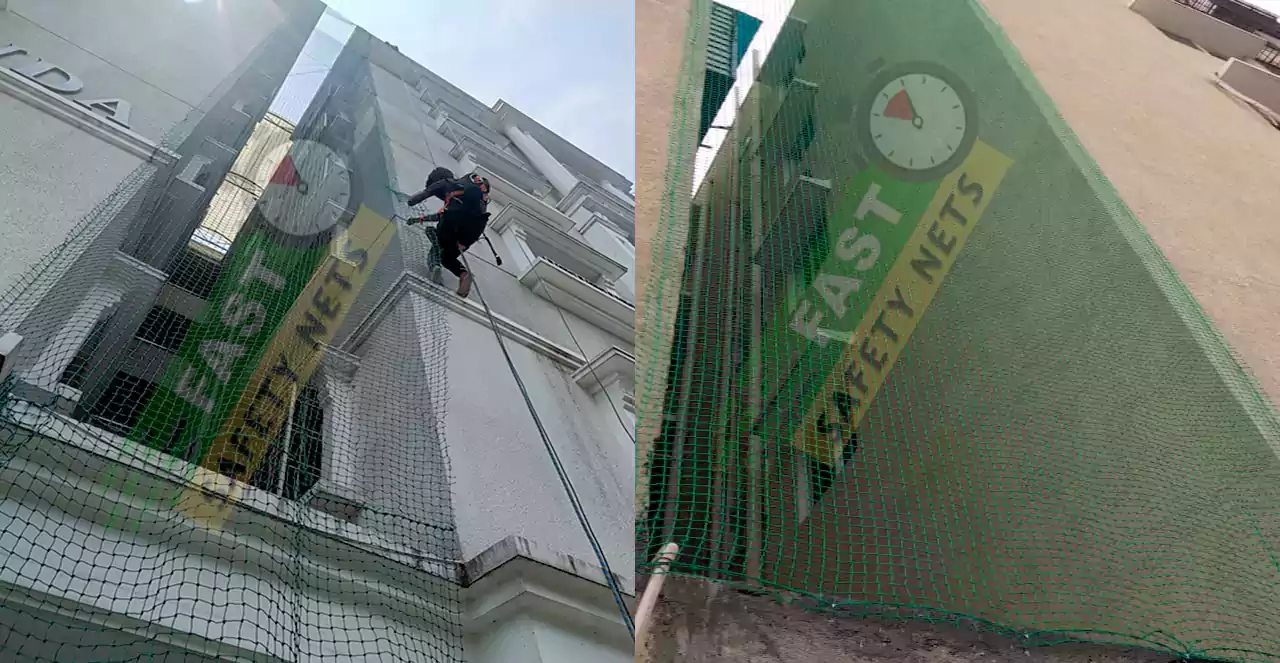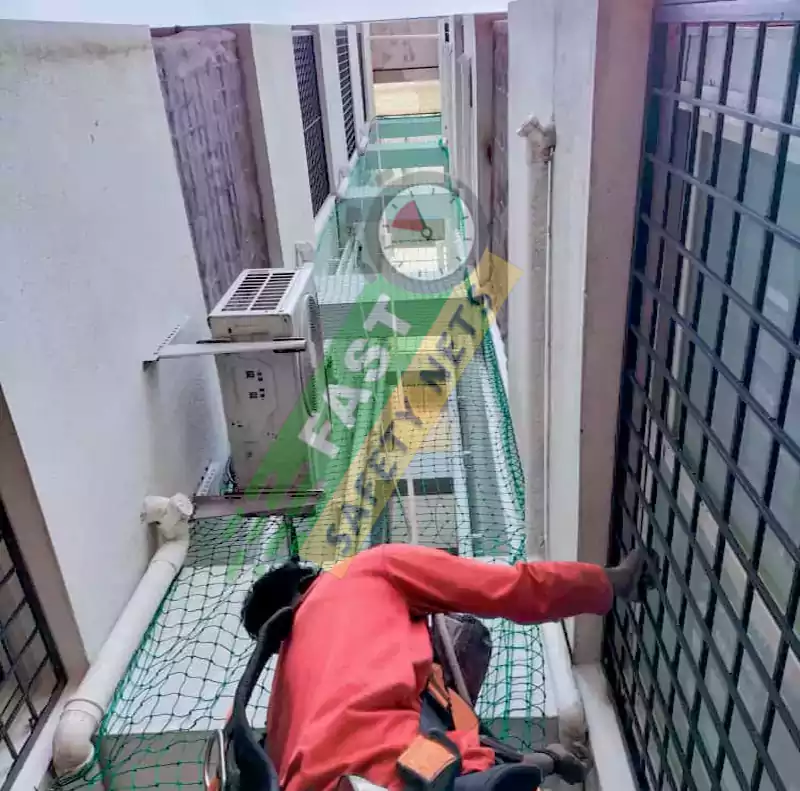
Duct Area Safety Nets are specialized netting systems designed specifically for bird prevention in duct areas of buildings. These nets are installed to create a physical barrier that deters birds from accessing duct openings, vents, or exhaust systems within buildings. Made of durable materials such as nylon or polyethylene, these nets are designed to withstand environmental conditions and provide long-term bird prevention solutions. Birds often seek shelter and nesting sites in duct openings, vents, or exhaust systems, leading to various issues such as contamination, blockages, and health hazards. By installing safety nets in duct areas, building owners and managers can effectively deter birds and mitigate the following risks:
Contamination: Bird droppings, feathers, and nesting materials can accumulate in duct systems, leading to contamination of air quality, surfaces, and equipment. Duct Area Safety Nets prevent birds from entering duct openings, reducing the risk of contamination and maintaining clean indoor environments.
Blockages: Bird nesting activities in duct areas can cause blockages or obstructions, impairing the functionality of HVAC systems, exhaust vents, or other ductwork. Safety nets prevent birds from building nests or debris in duct openings, ensuring unobstructed airflow and system efficiency.
Damage: Birds may cause damage to ductwork, insulation, or equipment within duct areas through nesting behaviors or physical contact. Safety nets act as a protective barrier, preventing birds from accessing sensitive components and minimizing the risk of damage or costly repairs.
Health Hazards: Bird droppings and nesting materials in duct areas can pose health hazards to building occupants, leading to respiratory problems, allergies, or transmission of diseases. Duct Area Safety Nets help maintain a hygienic and safe indoor environment by preventing bird-related health risks.
Duct Area Safety Nets are essential for several reasons, primarily focused on preventing bird infestation, protecting air quality, preventing damage, and ensuring compliance with health and safety regulations:
Preventing Bird Infestation in Duct Areas: Duct areas are vulnerable to bird infestation, as birds often seek shelter and nesting sites in vents, exhaust systems, or duct openings. Without proper protection, birds can enter ductwork, leading to contamination, blockages, and damage to HVAC systems. Safety nets act as a physical barrier, effectively preventing birds from accessing duct areas and nesting within them.
Protecting Air Quality and Preventing Damage: Bird infestation in duct areas can compromise indoor air quality and pose health risks to occupants. Bird droppings, feathers, and nesting materials can accumulate in ductwork, leading to contamination of air supply and surfaces. Additionally, birds may cause damage to duct insulation, equipment, or wiring through nesting behaviors. Safety nets help maintain clean air quality by preventing bird-related contamination and damage in duct areas, ensuring a healthier indoor environment.
Compliance with Health and Safety Regulations: Health and safety regulations mandate the maintenance of clean indoor environments and the prevention of hazards that may affect occupants' well-being. Bird infestation in duct areas can pose health hazards, including respiratory problems, allergies, or transmission of diseases. By installing safety nets in duct areas, building owners and managers demonstrate compliance with health and safety regulations, ensuring a safe and hygienic building environment for occupants.
When selecting Duct Area Safety Nets for effective bird prevention, it's essential to consider various factors such as material, size, mesh density, and special features. Here are some considerations to help you choose the right safety nets:
Choose durable materials such as nylon or polyethylene that are resistant to environmental factors and UV degradation. These materials provide longevity and reliability, ensuring effective bird prevention in duct areas.
Select safety nets that are sized appropriately to cover duct openings, vents, or exhaust systems effectively. Measure the dimensions of the duct areas to determine the required net size and ensure complete coverage.
Opt for safety nets with a tight mesh density that prevents birds from passing through while allowing for adequate airflow. A dense mesh helps deter birds effectively and minimizes the risk of intrusion into duct areas.
Look for safety nets with special features designed specifically for bird prevention in duct areas. These may include:
Overlapping or reinforced edges to prevent birds from accessing gaps or openings.
UV-resistant coatings or treatments to withstand prolonged exposure to sunlight and outdoor conditions.
Flame-retardant properties to comply with fire safety regulations in building environments.
Customizable options such as tailored shapes or sizes to fit unique duct configurations or architectural features.
Consider the ease of installation and compatibility with existing ductwork or structures. Choose safety nets that can be installed securely and efficiently, ensuring proper coverage and functionality in duct areas.
Select safety nets from reputable manufacturers or suppliers known for producing high-quality bird prevention solutions. Research customer reviews, certifications, and industry recommendations to ensure reliability and performance.
Balance cost considerations with the long-term value and effectiveness of the safety nets. Invest in quality materials and features that offer durability, reliability, and sustained bird prevention benefits over time.

Duct Area Safety Nets should be used in various situations and environments where there is a risk of bird infestation or intrusion into duct areas within buildings. Here are some scenarios when Duct Area Safety Nets are commonly used:
Commercial and Residential Buildings: Use Duct Area Safety Nets in commercial and residential buildings to prevent birds from accessing duct openings, vents, or exhaust systems. Bird infestation in duct areas can lead to contamination, blockages, and damage to HVAC systems, compromising indoor air quality and building functionality.
Industrial Facilities: Install Duct Area Safety Nets in industrial facilities, warehouses, or manufacturing plants to protect ductwork from bird intrusion. Birds may seek shelter or nesting sites in duct openings, posing risks to equipment, machinery, and product integrity.
Hospitals and Healthcare Facilities: Employ Duct Area Safety Nets in hospitals and healthcare facilities to maintain clean air quality and hygiene standards. Bird infestation in duct areas can introduce contaminants and pathogens, posing health risks to patients, staff, and visitors.
Educational Institutions: Use Duct Area Safety Nets in schools, colleges, or universities to prevent bird-related issues in ventilation systems. Bird droppings, feathers, or debris in ductwork can affect indoor air quality and contribute to respiratory problems or allergies among students and staff.
Food Processing Facilities: Install Duct Area Safety Nets in food processing plants or facilities to prevent bird contamination in ventilation systems. Bird presence in duct areas can compromise food safety standards and lead to product contamination, spoilage, or regulatory violations.
Historical Buildings or Monuments: Employ Duct Area Safety Nets in historical buildings, monuments, or heritage sites to protect ductwork and architectural features from bird damage. Bird infestation in duct areas can cause structural deterioration and aesthetic degradation over time.
Construction or Renovation Projects: Use temporary Duct Area Safety Nets during construction or renovation projects to prevent birds from entering exposed duct openings. Temporary nets provide interim bird prevention measures until permanent building features are in place.
Outdoor Installations or Structures: Install Duct Area Safety Nets in outdoor installations, structures, or equipment with exposed ductwork. Outdoor environments are susceptible to bird infestation, and safety nets help protect duct areas from intrusion and damage.
Installing Duct Area Safety Nets requires careful preparation, inspection of duct areas, and adherence to a step-by-step installation process. Here's a guide to installing safety nets for effective bird prevention:
Site Assessment: Conduct a thorough assessment of duct areas to identify openings, vents, or exhaust systems vulnerable to bird intrusion. Determine the size, shape, and configuration of ductwork to plan for appropriate net coverage.
Clearance and Accessibility: Ensure adequate clearance and accessibility to duct areas for installation. Clear obstructions or debris from the surrounding area to facilitate safe and efficient installation.
Inspection for Damage: Inspect ductwork for any signs of damage, leaks, or structural weaknesses. Address any repair or maintenance issues before proceeding with the installation of safety nets.
Safety Gear: Personal protective equipment (PPE) including gloves, safety glasses, and, if working at heights, harnesses and fall protection equipment.
Anchor Installation: Install anchor points or support structures securely around duct openings using appropriate fasteners. Ensure that anchors are spaced evenly and positioned to provide sufficient support for the safety nets.
Netting Layout: Lay out the safety netting material over duct openings, ensuring complete coverage and alignment with anchor points. Allow for sufficient overlap and clearance to prevent birds from accessing openings.
Attachment to Anchors: Attach one edge of the netting to the anchor points using suitable fasteners such as screws, bolts, or clips. Ensure that the netting is securely anchored and taut.
Tensioning the Netting: Use tensioning devices or ratchets to adjust the tension of the netting, ensuring that it is evenly tensioned and free from sagging or drooping. Tighten the netting gradually to achieve the desired tension.
Securing the Netting: Secure the remaining edges of the netting to the anchor points or support structures using the same fastening method as the initial attachment. Double-check that all connections are secure.
Trimming and Finishing: Trim any excess netting material and ensure that edges are properly secured and trimmed for a neat and professional finish. Dispose of trimmed materials properly.
Inspection and Testing: Conduct a final inspection of the installed safety nets to ensure that they are properly installed, securely anchored, and free from defects or damage. Test the integrity of the installation by applying gentle pressure to the netting and checking for any signs of movement or weakness.
Mission :Choosing Fast Safety Nets Chennai for Duct Area Safety Nets offers several advantages and benefits, making them a trusted provider for bird prevention solutions. Here are some reasons to choose Fast Safety Nets Chennai:
Duct Area Safety Nets are necessary to prevent bird infestation in duct areas, which can lead to contamination of air quality, equipment damage, and disruptions to operations. These nets provide an effective solution for maintaining clean and safe ductwork environments.
Duct Area Safety Nets are typically made of durable materials such as nylon or polyethylene mesh. These materials offer strength, durability, and resistance to environmental factors, making them suitable for use in duct areas.
Duct Area Safety Nets create a physical barrier that prevents birds from accessing duct openings, vents, or exhaust systems. The tight mesh structure of the nets deters birds from entering while allowing for adequate airflow within duct areas.
Yes, Duct Area Safety Nets can be customized to fit specific duct configurations, sizes, and shapes. Customization ensures proper coverage and effectiveness in preventing bird intrusion while accommodating unique duct layouts.
Copyright 2025 pigeonbalconynetting.com | All Right Reserved . Google Ads & SEO, Website Designed and Developed by isewis Technologies - www.isewis.com